Heywood J.B. Internal Combustion Engines Fundamentals
Подождите немного. Документ загружается.


Flow coefficients are
determined
experimentally and are a function of the
shape of the passage, the Reynolds number and Mach number of the flow, and
the gas properties. For a Mach number at the throat less than about
0.7
and for
passages of similar shape, the flow coefficient is essentially a function of Reynolds
number only.
Orifice
plates are frequently used to measure gas flow rates. Standard
methods for determining flows through orifice plates can
be
found
in
Ref.
3.
REFERENCES
1. Lichtarowicz,
A.,
Duggins,
R.
K.,
and
Markland,
E.:
"Discharge
Codficients for Incompressible
Non-Cavitating Flow through Long
Orifices,"
J.
Mech.
Eng.
Sci.,
vol.
7,
no.
2,
pp.
210-219,1965.
2. Taylor,
C.
F.:
The
Internal Combustion Engine in
Theory
and Practice,
vol. I,
p.
506,
MIT Press,
1966.
3.
Marks' Standmd
Handbookjiw
Mechanical Engineers,
8th
ed.,
McGraw-Hi, 1978.
APPENDIX
DATA
ON
WORKING
FLUIDS
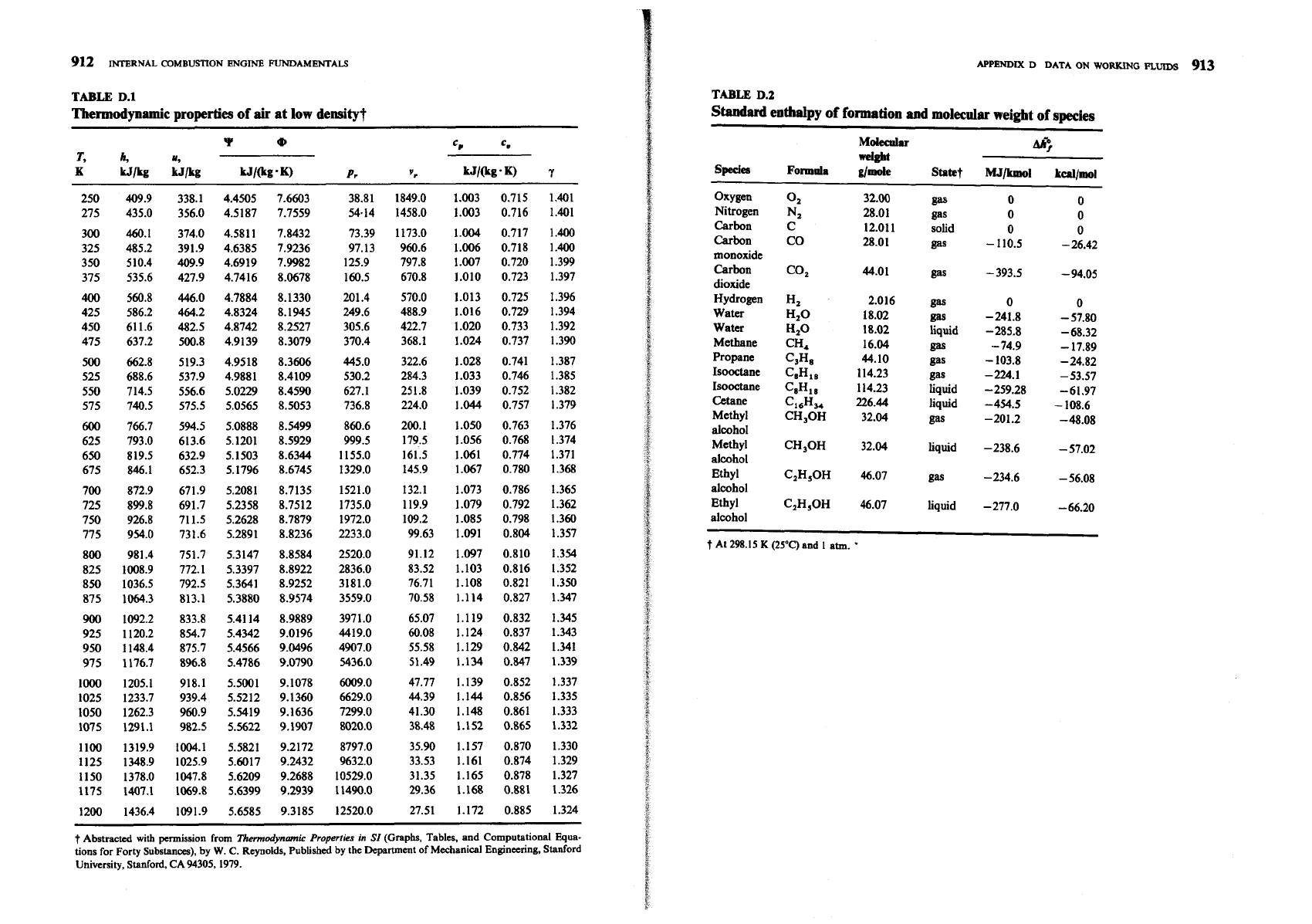
TABLE
D.l
Thermodynamic
properties of
air
at low density?
t
Abstracted
with
permission from
Thermodynamic Properties
in
SI
(Graphs, Tables, and Computational Equa-
tions for Forty Substances), by
W.
C.
Reynolds, Published by the Department of Mechanical Engineering, Stanford
University, Stanford, CA 94305,1979.
TABLE
D.2
Standard
entbalpy of formation
and
molecular weight of species
Mokeolu
mi*
@I
Sped-
Fornula
g/de
Statet
MJ/kmol
kd/mol
oxygen
0,
Nitrogen N,
Carbon C
Carbon CO
monoxide
Carbon CO,
dioxide
Hydrogen Hz
Water Hz0
Water H2O
Methane CH4
Propane C,H,
Ismtane C,H,,
Isooctane C,H,,
Cetane
'16~34
Methyl CH,OH
alwhol
Methyl CH,OH
alcohol
Ethyl C,H,OH
alcohol
Ethyl C2H,0H
alcohol
32.00
gas
28.01
gas
12.011 solid
28.01
gas
2.016
gas
18.02
gas
18.02 liquid
16.04
gas
44.10 gas
114.23
gaS
114.23 liquid
226.44 liquid
32.04
gas
32.04 liquid
46.07 liquid
t
At
298.15
K
(25•‹C)
and
I
atrn.
'
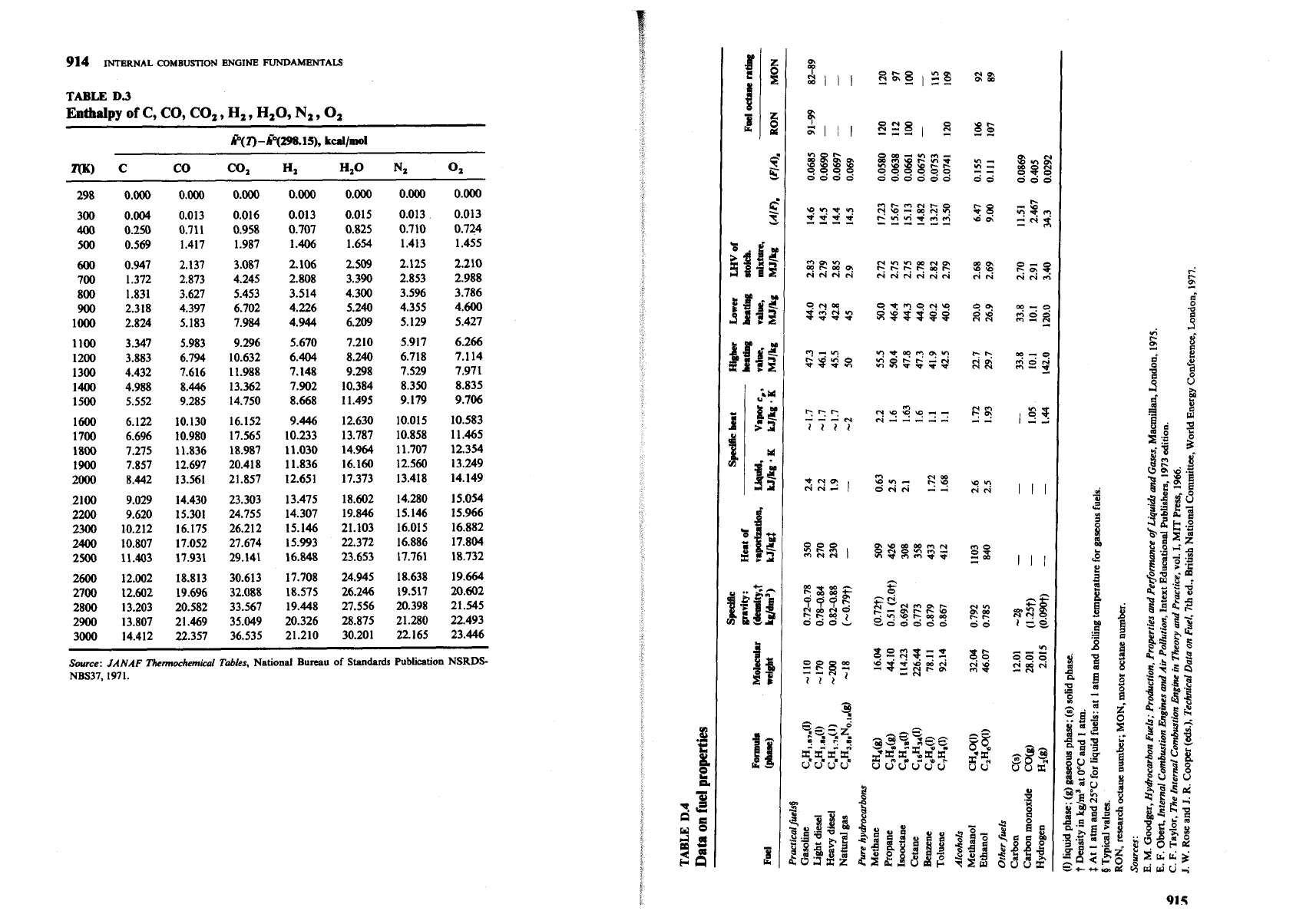
TABLE
D3
Enthalpy
of
C, CO, CO,
,
Hz,
H,O,
N,
,
0,
h'q
I)
-
&298.ls),
kcd/mol
T(K)
c
CO
CO, Ha Ha0
N,
0,
Source:
JANAF
Tkmochemiul Tables,
National Bureau of
Standards
Publication NSRDS
NBS37.1971.
*
qs3
"
-
1$81ap
gg
dxxx
xSsTdS
$3
"32
u'u'du'
8
umumSu"u"
58
x
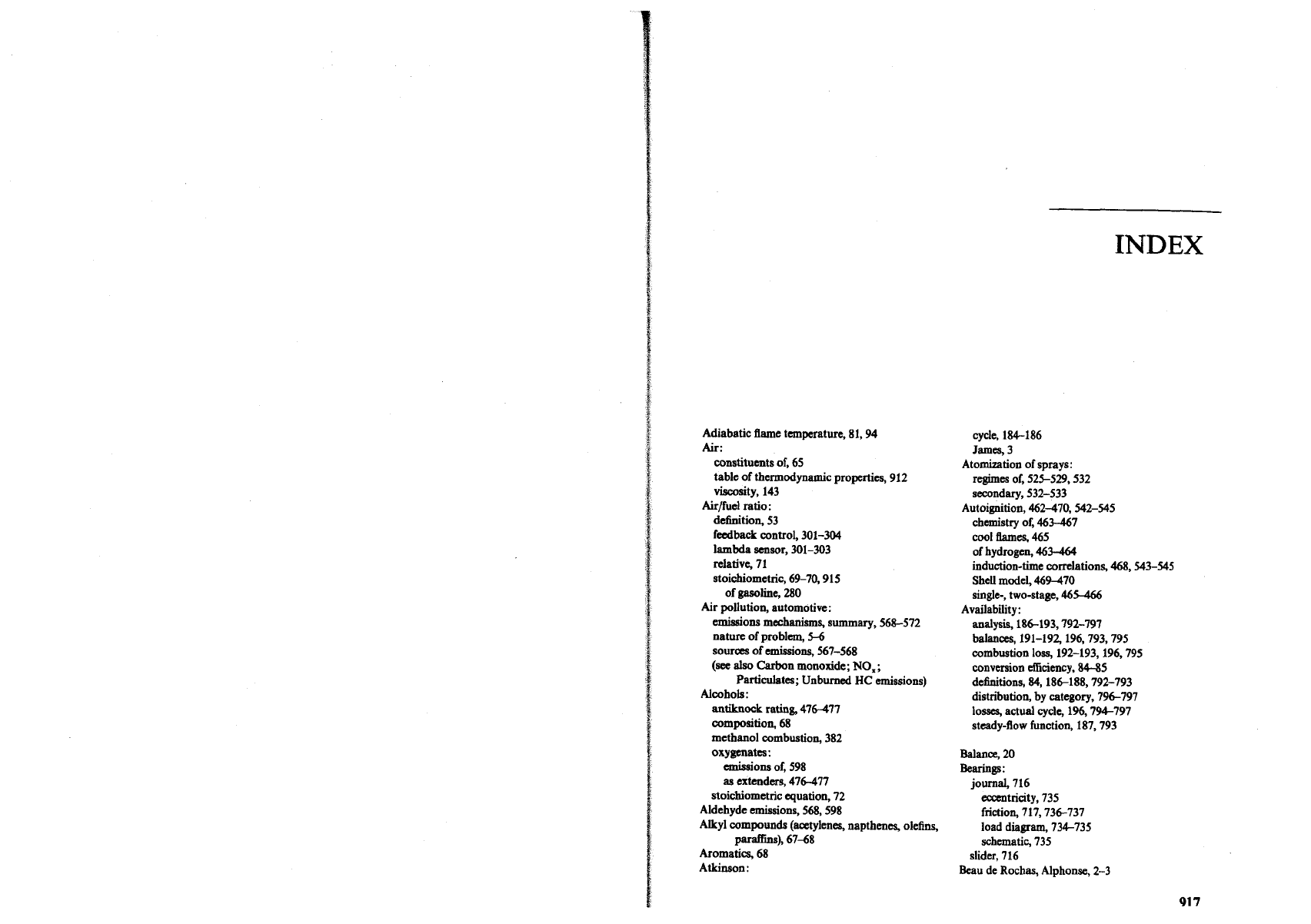
INDEX
Adiabatic flame temperature,
81,94
Air:
constituents of,
65
table of thermodynamic properties,
912
Viscosity,
143
Air/fuel ratio:
definition,
53
feedback control,
301-304
lambda sensor,
301-303
relative,
71
stoichiometric,
69-70,915
of gasoline,
280
Air pollution, automotive:
emissions mechanisms,
summary,
568-572
nature of problem,
5-6
sources of emissions,
567-568
(see
also
Carbon monoxide; NO,
;
Particulates; Unburned
HC
emissions)
Alcohols:
antiknock rating,
476-477
composition,
68
methanol combustion,
382
oxygenates
:
emissions of,
598
as extenders,
476-477
stoichiometric equation,
72
Aldehyde emissions,
568,598
Alkyl compounds (acetylenes, napthenes, olefins,
paraffins),
67-68
Aromatics,
68
Atkinson
:
cycle,
184-186
James,
3
Atomization of sprays:
regimes ot,
525429,532
secondary,
532-533
Autoignition,
462470,542-545
chemistry of,
463-467
cool
flames,
465
of hydrogen,
463-464
induction-time correlations,
468,543-545
SheU model,
469-470
single-, two-stage,
465-466
Availability:
analysis,
16193,792-797
balances,
191-192,196,793,795
combustion loss,
192-193,196,795
convemion efficiency,
84-85
definitions,
84,186188,792-793
distribution, by category,
796-797
losses, actual cycle,
196,796797
steady-flow function,
187,793
Balance,
20
Bearings:
journal,
716
eccentricity,
735
friction,
717,736-737
load
diagram,
734-735
schematic,
735
slider,
716
Beau de Rochas, Alphonse,
2-3
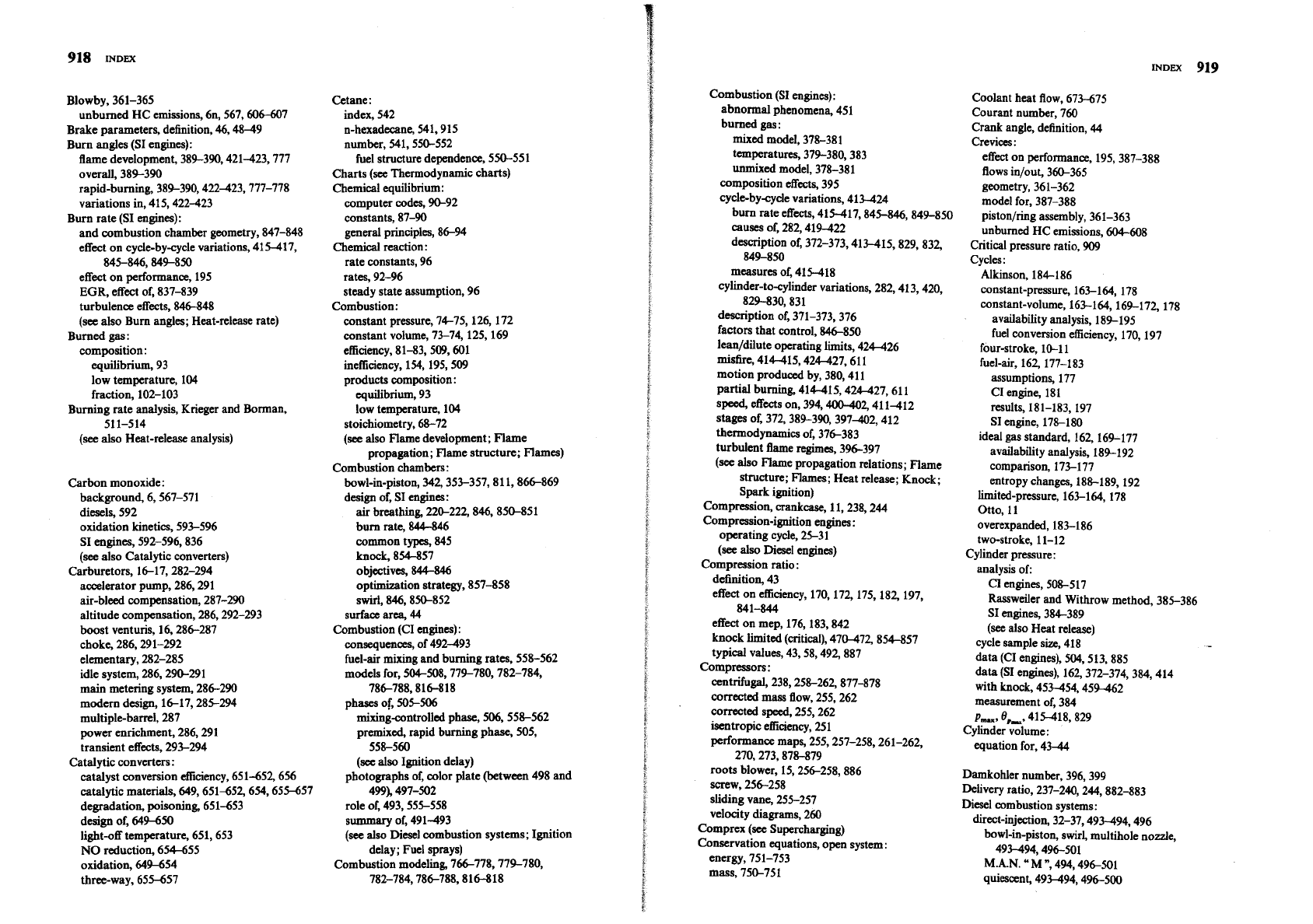
Blowby,
361-365
unburned HC emissions,
6n,
567,606607
Brake parameters, definition,
46,4849
Bum angles (SI engines):
flame development,
389-390,421-423,777
overall,
389-390
rapid-burning,
389-390,422423,777-778
variations in,
415,422-423
Bum rate (SI engines):
and combustion chamber geometry,
847-848
effect on cycle-bycycle variations,
415417,
845-846,849-850
effect on performance,
195
EGR,
effect of,
837-839
turbulence effects,
846-848
(see also Bum angles; Heat-release rate)
Burned gas
:
composition:
equilibrium,
93
low temperature,
104
fraction,
102-103
Burning rate analysis, Krieger and Bonnan,
511-514
(see also Heat-release analysis)
Carbon monoxide:
background,
6,567-57 1
diesels,
592
oxidation kinetics,
593-596
SI engines,
592-596,836
(see also Catalytic converters)
Carburetors,
16-17,282-294
accelerator pump,
286,291
air-bleed compensation,
287-290
altitude compensation,
286,292-293
boost venturis,
16,286-287
choke,
286,291-292
elementary,
282-285
idle system,
286,290-291
main metering system,
286290
modem design,
1617,285-294
multiple-barrel,
287
power enrichment,
286,291
transient effects,
293-294
Catalytic converters:
catalyst conversion efficiency,
651652,656
catalytic materials,
649,651652,654,65565
degradation, poisoning,
651453
design of,
649-650
light-off temperature,
651,653
NO reduction,
654-655
oxidation,
649-654
three-way,
655-657
Cetane:
index,
542
n-hexadecane,
541,915
number,
541,550-552
fuel structure dependence,
550-551
Charts (see Thermodynamic charts)
Chemical equilibrium:
computer codes,
90-92
constants,
87-90
general principles,
86-94
Chemical reaction
:
rate constants,
96
rates,
92-96
steady state assumption,
96
Combustion:
constant pressure,
7475,126,172
constant volume,
73-74,125,169
efficiency,
8143,509,601
inefficiency,
154,195,509
products composition:
equilibrium,
93
low temperature,
104
stoichiometry,
68-72
(see also Flame development; Flame
propagation; Flame structure; Flames)
Combustion chambers:
bowl-in-piston,
342,353-357,811,866-869
design of, SI engines:
air
breathing,
220-222,846,850-851
bum rate,
844-846
common types,
845
knock,
854-857
objectives,
844-846
optimization strategy,
857-858
swirl,
846,850-852
surface area,
44
Combustion (CI engines):
consequence, of
492493
fuel-air mixing and burning rates.
558-562
models for,
504-508,779-780,782-784,
786788,816-818
phases of,
505-506
mixing-controlled phase,
506,558-562
premixed, rapid burning phase,
505,
558-560
(see also Ignition delay)
photographs of, color plate (between
498
and
7 499), 497-502
role of,
493,555-558
summary of,
491493
(see
also Diesel wmbustion systems; Ignition
delay; Fuel sprays)
Combustion modeling,
766778,779-780,
782-784,786788,81648
Combustion (SI engines):
abnormal phenomena,
451
burned gas
:
mixed model,
378-381
temperatures,
379-384383
unmixed model,
378-381
composition effects,
395
cycle-byqcle variations,
413-424
bum rate effects,
415417,845-846,849-850
C~USCS
of,
282,419-422
description of,
372-373,413415,829,832,
849-850
measures of,
415-418
cylinder-tocylinder variations,
282,413,420,
829430,831
description of,
371-373,376
factors that control,
846-850
leanfdilute operating limits,
424426
misfin,
414415,424427,611
motion produced by,
38441 1
partial burning,
414-415,424-427,611
speed, effects on,
394,400-402,41142
stages of,
372,389-390,39742,412
thermodynamics of,
376383
turbulent flame regimes,
396397
(see
also Flame propagation relations; Flame
structure; Flames; Heat release; Knock;
Spark ignition)
Compression, crankcase,
11,238,244
Compression-ignition engines
:
operating cycle,
25-31
(see also Diesel engines)
Compression ratio
:
definition,
43
effect on eEciency,
170,172,175,182,197,
841-844
effect on mep,
176,183,842
knock limited (critical),
470472,854357
typical values,
43,58,492,887
Compressors:
centrifugal,
238,258-262,877-878
corrected mass flow,
255,262
corrected speed,
255,262
isentropic efficiency,
251
performance maps,
255,257-258,261-262,
270,273,878-879
roots blower,
15,256258,886
screw,
256-258
sliding vane,
255-257
velocity diagrams,
260
Comprex (see Supercharging)
Conservation equations, open system:
energy,
751-753
mass,
750-751
Coolant heat flow,
675675
Courant number,
760
Crank angle, definition,
44
Crevices:
effect on performance,
195,387-388
flows in/out,
360-365
geometry,
361-362
model for,
387-388
piston/ring assembly,
361-363
unburned HC emissions,
604-608
Critical pressure ratio,
909
Cycles:
Alkinson,
184-186
constant-pressure,
163-164, 178
constant-volume,
163-164,169-172, 178
availability analysis,
189-195
fuel conversion efficiency,
170,197
four-stroke,
10-1 1
fuel-air,
162, 177-183
assumptions,
177
CI engine,
181
results,
181-183, 197
SI engine,
178-180
ideal
gas
standard,
162, 169-177
availability analysis,
189-192
comparison,
173-177
entropy changes,
188-189,192
limited-pressure,
163-164, 178
Otto,
11
overexpanded,
183-186
two-stroke,
11-12
Cylinder pressure:
analysis of:
CI
engines,
508-517
Rassweiler and Withrow method,
385-386
SI engines,
384389
(see also Heat release)
cycle sample size,
418
data (CI engines),
504,513,885
data (SI engines),
162,372-374,384,414
with knock,
453-454.45942
measurement of,
384
p-,
8,-,
415418,829
Cylinder volume:
equation for,
434
Damkohler number,
396,399
Delivery ratio,
237-24,244,882483
Diesel wmbustion systems:
direct-injection,
32-37,493494,496
bowl-in-piston, swirl multihole nozzle,
493494,496-501
M.A.N.
"
M
",
494,496501
quiescent,
493-494,496500
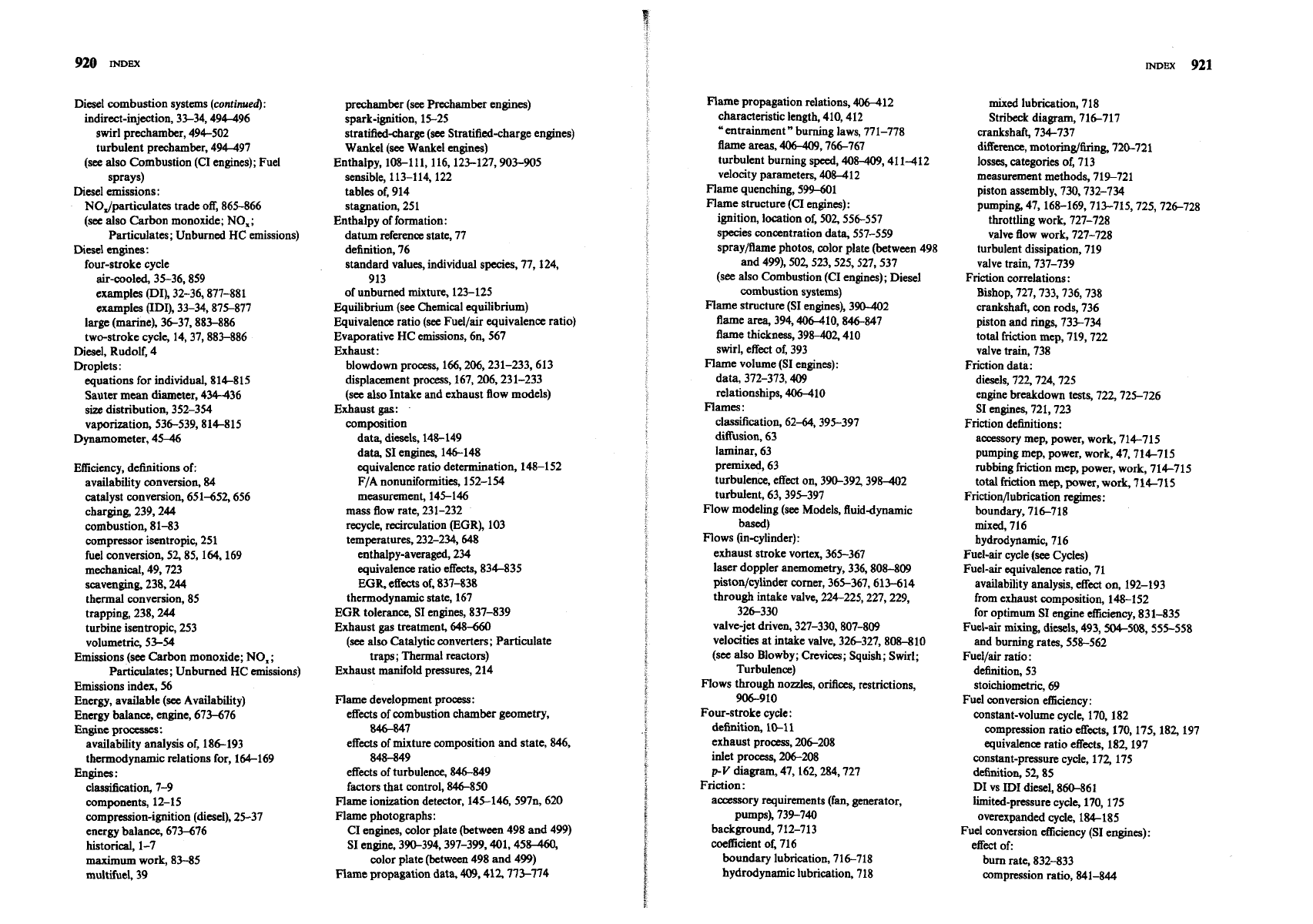
9U)
INDEX
Diesel combustion systems (continued):
indirect-injection,
33-34,494-496
swirl prechamber,
494-502
turbulent prechamber,
494-497
(see also Combustion (CI engines); Fuel
sprays)
Diesel emissions
:
NOJparticulates trade off,
865-866
(see also Carbon monoxide; NO,;
Particulates; Unburned HC emissions)
Diesel engines:
bur-stroke cycle
air-cooled,
35-36.859
examples (DI),
32-36,877-881
examples (IDI),
33-34,875-877
large (marine),
3637,883-886
two-stroke cycle,
14,37,883-886
Diesel, Rudolf,
4
Droplets:
equations for individual,
814-815
Sauter mean diameter,
434-436
size distribution,
352-354
vaporization,
536539,814815
Dynamometer,
45-46
Efficiency, definitions of:
availability conversion,
84
catalyst conversion,
651652,656
charging,
239,244
combustion,
81-83
compressor isentropic,
251
fuel conversion,
52, 85,164,169
mechanical,
49,723
scavenging,
238,244
thermal conversion,
85
trapping,
238,244
turbine isentropic,
253
volumetric,
53-54
Emissions (see Carbon monoxide; NO,;
Particulates; Unburned HC emissions)
Emissions index,
56
Energy, available (see Availability)
Energy balance, engine,
673-676
Engine processes:
availability analysis of,
186193
thermodynamic relations for,
164-169
Engines
:
classification,
7-9
components,
12-15
compression-ignition (diesel),
25-37
energy balance,
673-676
historical,
1-7
maximum work,
83-85
multifuel,
39
prechamber (see Pmhamber engines)
spark-ignition,
15-25
stratified~har~e (see Stratified-charge engines)
Wankel (see Wankel engines)
Enthalpy,
108-111,116,123-127,903-905
sensible,
113-114, 122
tables of,
914
stagnation,
251
Enthalpy of formation:
datum reference state,
77
definition,
76
standard values, individual species,
77, 124,
913
of unburned mixture,
123-125
Equilibrium
(see
Chemical equilibrium)
Equivalence ratio (see Fuellair equivalence ratio)
Evaporative HC emissions,
6n,
567
Exhaust:
blowdown process,
166,206,231-233,613
displacement process,
167,206,231-233
(see also Intake and exhaust flow models)
Exhaust
gas:
composition
data, diesels,
148-149
data, SI engines,
146-148
equivalence ratio determination,
148-152
F/A nonuniformities,
152-154
measurement,
145-146
mass flow rate,
231-232
recycle, recirculation (EGR),
103
temperatures,
232-234,648
enthalpy-averaged,
234
equivalence ratio effects,
834-835
EGR, effects of,
837-838
thermodynamic state,
167
EGR tolerance, SI engines,
837-839
Exhaust gas treatment,
648-660
(see also Catalytic converters; Particulate
traps; Thermal reactors)
Exhaust manifold pressures,
214
Flame development process
:
effects of combustion chamber geometry,
846447
effects of mixture composition and state,
846,
848-849
effects of turbulence,
846-849
factors that control,
846-850
Flame ionization detector,
145-146,597n, 620
Flame photographs:
CI engines, color plate (between
498
and
499)
SI engine,
390-394,397-399,401,458450,
color plate (between
498
and
499)
Flame propagation data,
409,412,773-774
Flame propagation relations,
406-412
characteristic length,
410,412
"entrainment" burning laws,
771-778
flame
areas,
406409,766767
turbulent burning speed,
408-409,411412
velocity parameters,
408-412
Flame quenching,
599-601
Flame structure
(CI
engines):
ignition, location of,
502,556557
species concentration
data,
557-559
spraylflame photos, color plate (between
498
and
499), 502,523,525,527,537
(see also Combustion (CI engines); Diesel
combustion systems)
Flame structure (SI engines),
390-402
flame area,
394,406410,846-847
flame thickness,
398402,410
swirl, effect of,
393
Flame volume (SI engines):
data,
372-373,409
relationships,
406-410
Flames:
classification,
62-64.395-397
diffusion,
63
laminar,
63
premixed,
63
turbulence, effect on,
390-392,398402
turbulent,
63,395-397
Flow modeling (see Models, fluiddynamic
based)
Flows (i-cylinder):
exhaust stroke vortex,
365-367
laser doppler anemometry,
336,808-809
piston/cylinder corner,
365-367,613-614
through intake valve,
224225,227,229,
326330
valve-jet driven,
327-330,807-809
velocities at intake valve,
326327,808-810
(see also Blowby; Crevices; Squish; Swirl;
Turbulence)
Flows through nozzles, orifices, restrictions,
906910
Four-stroke cycle
:
definition,
10-11
exhaust proass,
206-208
inlet process,
206-208
pV
diagram,
47,162,284,727
Friction
:
accessory requirements (fan, generator,
pumps),
739-740
background,
712-71 3
coefficient of,
716
boundary lubrication,
716-718
hydrodynamic lubrication,
718
mixed lubrication,
718
Stribcck diagram,
716-717
crankshaft,
734-737
difference, motorinB/firing,
720-721
losses, categories of,
713
measurement methods,
719-721
piston assembly,
730,732-734
pumping, 47,168-169,713-715,725,726728
throttling work,
727-728
valve flow work,
727-728
turbulent dissipation,
719
valve train,
737-739
Friction correlations
:
Bishop,
727,733,736,738
crankshaft, con rods,
736
piston and rings,
733-734
total friction mep,
719,722
valve train,
738
Friction data:
diesels,
722,724,725
engine breakdown tests,
722,725-726
SI engines,
721,723
Friction definitions:
accessory mep, power, work,
714-715
pumping mep, power, work,
47,714-715
rubbing friction mep, power, work,
714-715
total friction mep, power, work,
714-715
Fri~tion~lubrication regimes:
boundary,
716718
mixed,
716
hydrodynamic,
716
Fuel-air cycle
(see
Cycles)
Fuel-air equivalence ratio,
71
availability analysis, effect on,
192-193
from exhaust composition,
148-152
for optimum SI engine efficiency,
831-835
Fuel-air mixing, diesels,
493,504408, 555-558
and burning rates,
558-562
Fuellair ratio
:
definition,
53
stoichiometric,
69
Fuel conversion efficiency:
constant-volume cycle,
170, 182
compression ratio effects,
170,175,182,197
equivalence ratio effects,
182,197
constant-pressure cycle,
172, 175
definition,
52, 85
DI vs ID1 diesel,
860-861
limited-pressure cycle,
170, 175
overexpanded cycle,
184-185
Fuel conversion efficiency (SI engines):
effect of:
bum rate,
832-833
compression ratio,
841-844
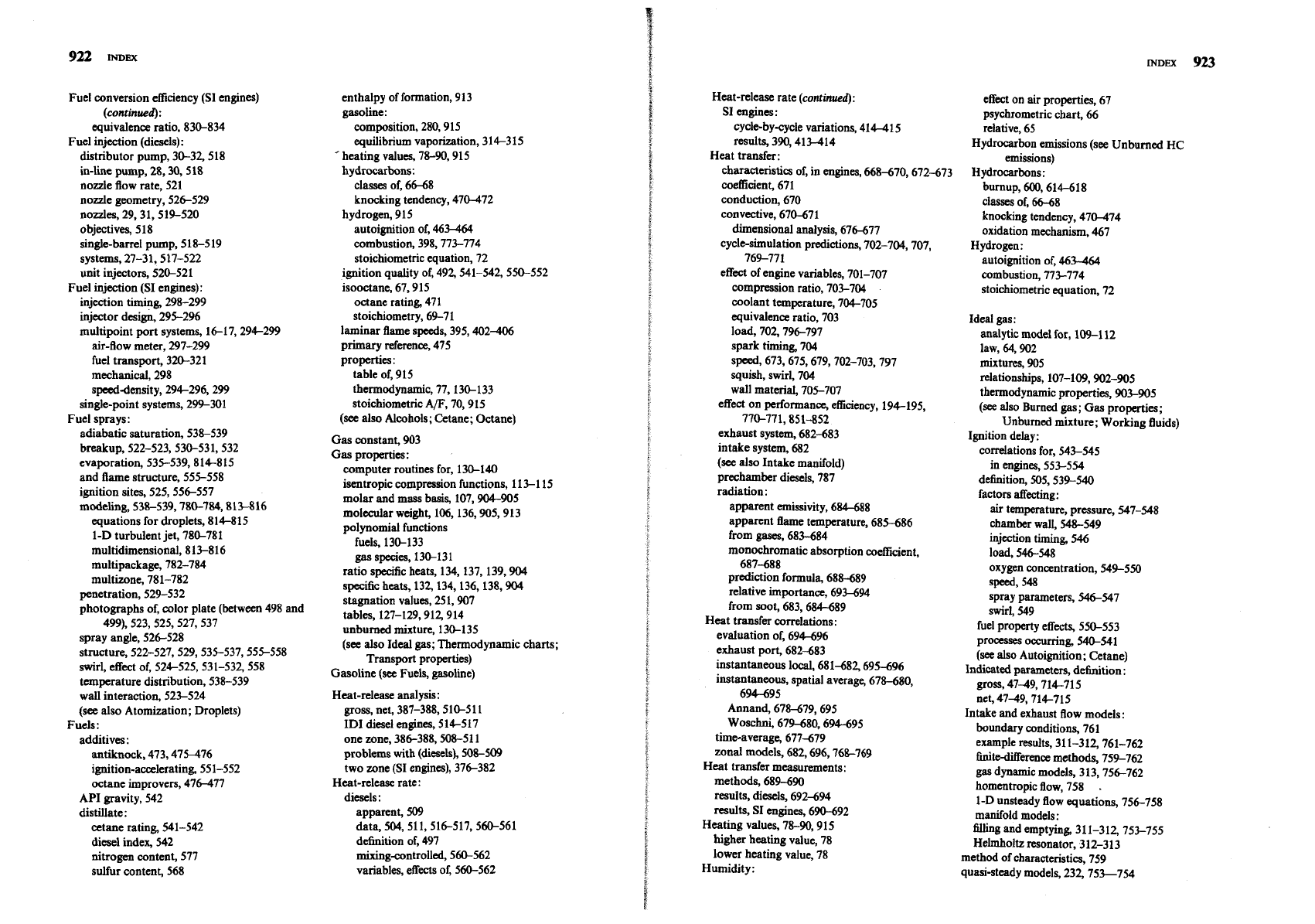
Fuel conversion efficiency (SI engines)
(continued)
:
equivalence ratio,
830-834
Fuel injection (diesels):
distributor pump,
30-32,518
in-line pump,
28,M, 518
nozzle flow rate,
521
nozzle geometry,
526529
nozzles,
29,31,519-520
objectives,
518
single-barrel pump,
518-519
systems,
27-31,517-522
unit injectors,
520-521
Fuel injection (SI engines):
injection timing,
298-299
injector design,
295-296
multipoint port systems,
16-17, 294-299
air-flow meter,
297-299
fuel transport,
320-321
mechanical,
298
specddensity,
294296,299
single-point systems,
299-301
Fuel sprays:
adiabatic saturation,
538-539
breakup,
522-523,530-531,532
evaporation,
535-539,814-815
and flame structure,
555-558
ignition sites,
525,556557
modeling,
538-539,780-784,813-816
equations for droplets,
814-815
1-D
turbulent jet,
780-781
multidimensional,
813-81 6
multipackage,
782-784
multizone,
781-782
penetration,
529-532
photographs of, color plate (between
498
and
499), 523, 525,527, 537
spray angle,
526528
structure,
522-527,529,535-537,555-558
swirl, effect of,
524-525,531-532.558
temperature distribution,
538-539
wall interaction,
523-524
(see also Atomization; Droplets)
Fuels
:
additives:
antiknock,
473,475-476
ignition-accelerating,
551-552
octane improvers,
476-477
API gravity,
542
distillate:
cetane rating,
541-542
diesel index,
542
nitrogen content,
577
sulfur content,
568
enthalpy of formation,
913
gasoline:
composition,
280,915
equilibrium vaporization,
314-3 15
"
heating values,
78-90,915
hydrocarbons:
classes of,
66-68
knocking tendency,
470-472
hydrogen,
915
autoignition of,
463464
cornbustion,
398,773-774
stoichiometric equation,
72
ignition quality of,
492,541-542,550-552
isooctane,
67,915
octane rating,
471
stoichiometry,
69-71
laminar flame speeds,
395,402406
primary reference,
475
properties
:
table of,
915
thermodynamic,
77,130-133
stoichiometric A/F,
70,915
(see also Alcohols; Cetane; Octane)
Gas constant,
903
Gas
properties:
computer routines for,
130-140
isentropic compression functions,
113-1 15
molar and mass basis,
107,904-905
molecular weight,
106,136,905,913
polynomial functions
fuels,
130-133
gas
species,
130-131
ratio specfic heats,
134, 137,139,904
specific heats,
132,134,136,138,904
stagnation values,
251,907
tables,
127-129,912,914
unburned mixture,
130-135
(see also Ideal
gas;
Thermodynamic charts;
Transport properties)
Gasoline
(set
Fuels, gasoline)
Heat-release analysis:
gross, net,
387-388,510-511
ID1 diesel engines,
514-517
one zone,
386-388.508-51
1
problems with (d'tesels),
508-509
two zone (SI engines),
376382
Heat-release rate:
diesels
:
apparent,
509
data,
504,511,516-517,560-561
definition of,
497
mixingcontrolled,
560-562
variables, effects of,
560-562
Heat-release rate (continued):
SI engines:
cycle-bycycle variations,
414-415
results,
390,413414
Heat transfer:
characteristics of, in engines,
668470,672473
coefficient,
671
conduction,
670
convective,
670-671
dimensional analysis,
676-677
cycle-simulation predictions,
702-704,707,
769-771
effect of engine variables,
701-707
compression ratio,
703-704
coolant temperature,
704-705
equivalence ratio,
703
load,
702,796-797
spark timing,
704
speed,
673,675,679,702-703,797
squish, swirl,
704
wall material,
705-707
effect on performance, efficiency,
194-195,
770-771,851-852
exhaust system,
682683
intake system,
682
(see also Intake manifold)
prechamber diesels,
787
radiation:
apparent emissivity,
684-688
apparent flame temperature,
685-686
from gases,
683-684
monochromatic absorption coefficient,
687688
prediction formula
688-689
relative importance,
693-694
from soot,
683,684-689
Heat transfer correlations:
evaluation of,
694-696
exhaust port,
682683
instantaneous local,
681482,695-696
instantaneous, spatial average,
67-80,
694-695
Annand,
678479,695
Woschni,
679-680,694-695
time-average,
677679
zonal models,
682,696,768-769
Heat transfer measurements:
methods,
689-690
results, diesels,
692694
results, SI engines,
690-692
Heating values,
78-90,915
higher heating value,
78
lower heating value,
78
Humidity:
effect on air properties,
67
psychrometric chart,
66
relative,
65
Hydrocarbon emissions (see Unburned HC
emissions)
Hydrocarbons
:
burnup,
600,614-61 8
classes of,
6668
knocking tendency,
470474
oxidation mechanism,
467
Hydrogen:
autoignition of,
463-464
combustion,
773-774
stoichiometric equation,
72
Ideal gas:
analytic model for,
109-1
12
law,
64,902
mixtures,
905
relationships,
107-109,902-905
thermodynamic properties,
903-905
(see
also Burned
gas;
Gas properties;
Unburned mixture; Working fluids)
Ignition delay:
correlations for,
543-545
in engines,
553-554
delinition,
505,539-540
factors
affecting:
air
temperature, pressure,
547-548
chamber wall,
548-549
injection timing,
546
load,
546-548
oxygen concentration,
549-550
speed,
548
spray parameters,
546-547
swirl,
549
fuel property effects,
550-553
processes occurring,
540-541
(see
also Autoignition; Cetane)
Indicated parameters, dehition
:
gross,
47-49,714-715
net,
4749,714-715
Intake and exhaust flow models:
boundary conditions,
761
example results,
311-312,761-762
finitedifference methods,
759-762
gas
dynamic models,
3 13,756-762
homentropic flow,
758
.
1-D
unsteady flow equations,
756758
manifold models:
wing and emptying,
311-312,753-755
Helmholtz resonator,
312-313
method of characteristics,
759
quasi-steady models,
232, 753-754

924
INDEX
Intake manifold:
air
flow,
309-313
description of,
309-31
1
transient behavior,
310-312
(see also Intake and exhaust flow models)
design,
308-309
fuel transport,
314-321
droplet behavior,
316-317
liquid films,
315-316,318-320
transient behavior,
310-312,318-321
vaporization,
314-321
pressure variation,
212-214,216,310-311
IC engines
(see
Engines)
Internal energy,
108-1 11,116-127,903-905
sensible,
113-114, 122
Internal energy of formation:
standard values,
124
of unburned mixture,
123-125
Knock
:
antiknock additives,
4,473,475-476
lead alkyls,
4,473,475-476
MMT,
475476
characterization of,
4-56
combustion photographs,
458-461
damage,
456457
deposit effects on,
477478
description of,
375,450-457
detection,
454
effect on heat transfer,
707
end gas,
457462,467470
temperature,
468-469
impact of,
456457,852-854
intensity,
45-56
pressure waves,
461-462
sensors,
872
theories
:
autoignition,
457458,462
detonation,
457458
(see also Autoignition; Compression ratio;
Fuels; Octane)
Laminar flame:
speed,
395,402-
correlations,
403-406
data,
403-405
and SI engine combustion,
771-775,
777-778,848-849
straining effects,
406
thickness,
395,402
Langen, Eugen,
2
Lead alkyls,
4,473,475-476
Lenoir,
J.
J.
E.,
2
Lubricant:
requirements,
741-745
SAE viscosity classification,
744-745
Lubrication:
of bearings,
71 5-718,734-737
of piston assembly,
729-734
regimes of,
716-718
system layout,
740-741
(see also Friction; Bearings)
Manifolds
:
tuning of,
215,217-218
(see also Exhaust manifold; Intake manifold)
Mass fraction burned, SI engines:
data,
372-373,382,777-778
equations for,
377-378,381-382390
Wiebe function,
390,768
Maximum work,
83-85
(see also Availability)
Mean effective pressure:
coefficient of variation (COV),
417,424-425
cycle-by-cycle variations,
417,425
definitions,
50,714-715
friction,
-714-715,825-827
fuel-air cycle results,
183
ideal cycles,
171,173,176
importance of,
59,823-824
overexpanded cycle,
185-186
pumping,
169,714-715
relationships for,
50-51,57,823-824
Mean effective pressure (DI diesels):
effect of:
injection parameters,
863-864
load and speed,
858460,877-878
full load,
826-827
Mean effective pressure (ID1 diesels):
effect of:
injection parameters,
863-864
load and speed,
860,875-876
full load,
826-827
Mean effective pressure (SI engines):
effect of:
compression ratio,
842
equivalence ratio,
83C832
heat transfer,
851
wide open throttle,
824-827,839-840
Mechanical efficiency:
definition,
49
values, SI engine,
722-723
Methanol combustion (SI engine),
382
Mixture nonuniformity, quality,
152-154,282,
314,829-832
Mixture requirements (SI engines),
279-282,
833-834
steady, transient,
834
typical schedules,
281-282
Models of engine processes, rationale,
748-750
Models, fluiddynamic based (multidimensional)
for boundary layers,
803
of combustion,
816-818
flow field predictions,
360,807-813
concentration distributions,
81 1-813
particle traces,
810-812
velocities,
807-8
11
governing equations,
798-799
KIVA code,
803,804,815416
numerical methodology,
798,80-07
computing mesh,
804405,810
discretization practices,
804-8015
solution algorithms,
806-807
overview,
797-798
sprays,
813-816
turbulence models:
full-field modeling,
799-802
k-E models,
775-777,801-802,808,810
largeeddy simulation,
799
Reynolds stress,
802
subgrid scale,
802-803
Models, thermodynamiobased
(phenomenological, zero-dimensional):
complex engine systems,
789-792
transient behavior,
791-792
turbocharged/turbocompounded,
789-792
DI diesels
:
model structure,
784-785
simulation results,
784-785
single zone combustion models,
778-780
spray models,
780-784
(see also Fuel sprays)
emissions,
765,787-788
ID1 diesels,
784-788
prechamber phenomena,
784-787
simulation results,
787-788
open system conservation equations,
763-765
overall structure,
762-763
SI engines:
combustion models,
766-778
cycle simulation results,
769-771
"entrainment
"
burning laws,
771-778
flame geometry models,
766-768
stochastic models,
787-788
turbulence intensity models,
775-777
(see
also Mass fraction burned)
Mole,
903
Molecular weights, values,
913
Moment of inertia of charge,
353
NO concentrations, in-cylinder:
DI diesel,
587-589
ID1 diesel,
589-590
SI engines,
579-581
NO formation:
description of, CI engines,
586587
equivalence ratio, effect of,
575-576
kinetics of,
572-576
rate constants,
573
Zeldovich mechanism,
572
model for, SI engines,
578-581
rate equation for,
573-574
temperature, effect of,
574-576
NO from fuel N,
577
Nitrogen, atmospheric,
65
NO, formation,
577-578
NO,, definition of,
567,572
NO, emissions (diesels):
effect of:
diluents,
590491,861-863
equivalence ratio,
588-589
EGR,
590-591,861-863
injection parameters,
863-867
load,
861-862
swirl,
866-867
flame
temperature correlation,
591-592
(see also NO formation)
NO, emissions (SI engines):
effect of:
compression ratio,
844
diluents,
582-584
equivalence ratio,
581-585, 83-36
EGR,
582-585,836-838
load, speed,
840-841
spark timing,
585586,829
(see
also Catalytic converters; NO formation)
Noise,
5,571-572
Octane:
antiknock index,
474
fuel sensitivity,
473-474
and knock,
854-855
number,
471474
motor method,
471473
requirement,
453,474,478,852-857
research method,
471473
road,
474
oxygenates as extenders,
476-477
ratings of fuels,
915
Odor, diesel,
568
Oil consumption rate,
610
Organic compounds
:
classes of,
66-68
(see also Fuels)
Otto:
cycle,
11
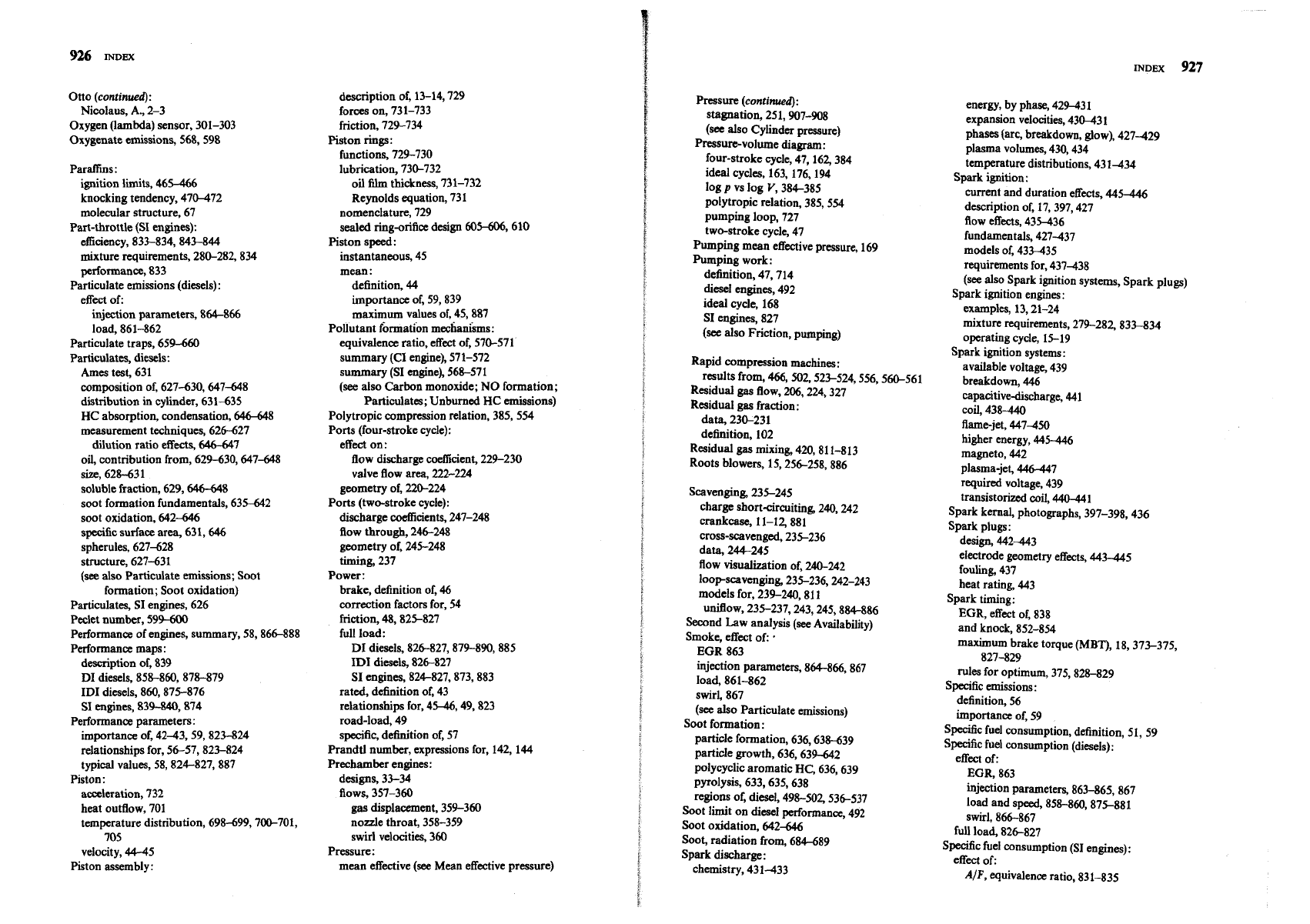
Otto (continued):
Nicolaus, A.,
2-3
Oxygen (lambda) sensor,
301-303
Oxygenate emissions,
568,598
Paralftns
:
ignition limits,
465-466
knocking tendency,
470472
molecular structure,
67
Part-throttle (SI engines):
efficiency,
833-834,843-844
mixture requirements,
280-282,834
performance,
833
Particulate emissions (diesels):
effect of:
injection parameters,
864-866
load,
861-862
Particulate traps,
659-660
Particulates, diesels:
Ames test,
631
composition of,
627430,647-648
distribution in cylinder,
631635
HC absorption, condensation,
646-648
measurement techniques,
626-627
dilution ratio effects,
646-647
oil, contribution from,
629430,647448
size,
628-63 1
soluble fraction,
629,646-648
soot formation fundamentals,
635-642
soot oxidation,
642-646
specific surface area,
63 1,646
spherules,
627428
structure,
627431
(see
also Particulate missions; Soot
formation; Soot oxidation)
Particulates, SI engines,
626
Peclet number,
599600
Performance of engines, summary,
58,866-888
Performance maps:
description of,
839
DI diesels,
858-860,878-879
ID1 diesels,
860.875476
SI engines,
839-840,874
Performance parameters:
importance of,
4243,59,823-824
relationships for,
56-57,823-824
typical values,
58,824427,887
Piston:
ac~xleration,
732
heat outflow,
701
temperature distribution,
698499,700-701,
705
velocity,
44-45
Piston assembly:
description of,
13-14,729
forces on,
731-733
friction,
729-734
Piston rings:
functions,
729-730
lubrication,
730-732
oil
film
thickness,
731-732
Reynolds equation,
731
nomenclature,
729
sealed ring-orifice design
605606,610
Piston speed:
instantaneous,
45
mean
:
definition,
44
importance of,
59,839
maximum values of,
45,887
Pollutant fbrmation mechanisms:
equivalence ratio, effect of,
570-571
summary
(CI
engine),
571-572
summary (SI engine),
568-571
(see also Carbon monoxide; NO formation;
Particulates; Unburned
HC
emissions)
Polytropic compression relation,
385, 554
Ports (four-stroke cycle):
effect on
:
flow discharge coeficient,
229-230
valve flow area,
222-224
geometry of,
220-224
Ports (two-stroke cycle):
discharge coefiicients,
247-248
flow through,
246-248
geometry of,
245-248
timing,
237
Power:
brake, definition of,
46
correction factors for,
54
friction,
48,825-827
full load:
DI
diesels,
826827,879-890,885
ID1 diesels,
826-827
SI engines,
824-827,873,883
rated, definition of,
43
relationships for,
454%. 49,823
road-load,
49
specific, definition of,
57
Prandtl number, expressions for,
142, 144
Prechamber engines:
designs,
33-34
flows,
357-360
gas displacement,
359-360
node throat,
358-359
swirl velocities,
360
Pressure:
mean effective (see Mean effective pressure)
Pressure (continued):
stagnation,
251,907-908
(sae
also Cylinder pressure)
Pressure-volume diagram:
four-stroke cycle,
47, 162, 384
ideal cycles,
163,176,194
log
p
vs log
V,
384-385
polytropic relation,
385,554
pumping loop,
727
two-stroke cycle,
47
Pumping mean effective pressure,
169
Pumping work:
definition,
47,714
diesel engines,
492
ideal cycle,
168
SI engines,
827
(see also Friction, pumping)
Rapid compression machines:
results from,
466,502,523-524,556,560461
Residual gas flow,
206,224,327
Residual gas fraction:
data,
230-231
definition,
102
Residual
gas
mixing,
420,811-813
Roots blowers,
15,256-258,886
Scavenging,
235-245
charge short-circuiting,
240,242
crankcase,
11-15881
cross-scavenged,
235-236
data,
244-245
flow visualization of,
240-242
loopscavenging,
235-236,242-243
models for,
239-240,811
uniflow,
235-237,243,245,884886
Second Law analysis (see Availability)
Smoke, effect of:
.
EGR
863
injection parameters,
864866,867
load,
861-862
swirl,
867
(see
also Particulate emissions)
Soot formation:
particle formation,
636,638-639
particle growth,
636,639-642
polycyclic aromatic HC,
636,639
pyrolysis,
633,635,638
regions of, diesel,
498-502,536537
Soot limit on diesel performance,
492
Soot oxidation,
642-646
Soot, radiation from,
684-689
Spark discharge:
chemistry,
431433
energy, by phase,
429-43 1
expansion velocities,
43043 1
phases (arc, breakdown, glow),
427-429
plasma volumes,
430,434
temperature distributions,
431434
Spark ignition:
current and duration effects,
445-44
description of,
17,397,427
flow effects,
435-436
fundamentals,
427437
models of,
433-435
requirements for,
437438
(see
also Spark ignition systems, Spark plugs)
Spark ignition engines:
examples,
13,21-24
mixture requirements,
279-282, 83-34
operating cycle,
15-19
Spark ignition systems:
available voltage,
439
breakdown,
446
capacitive-discharge,
441
coil,
438-440
flame-jet,
447-450
higher energy,
445-446
magneto,
442
plasma-jet,
446447
required voltage,
439
transistorized coil,
440-441
Spark kernal, photographs,
397-398,436
Spark plugs:
design,
442443
electrode geometry effects,
443-445
fouling,
437
heat rating,
443
Spark timing:
EGR,
effect of,
838
and knock,
852-854
maximum brake torque (MBT),
18,373-375,
827-829
rules for optimum,
375,828-829
Specific emissions:
definition,
56
importance of,
59
Specific fuel consumption, definition,
51, 59
Specific fuel consumption (diesels):
effect of:
EGR,
863
injection parameters,
863-865, 867
bad and speed,
858-860,875-881
swirl,
866-867
full load,
826827
Specific fuel consumption (SI engines):
effect of:
AIF,
equivalence ratio,
831-835
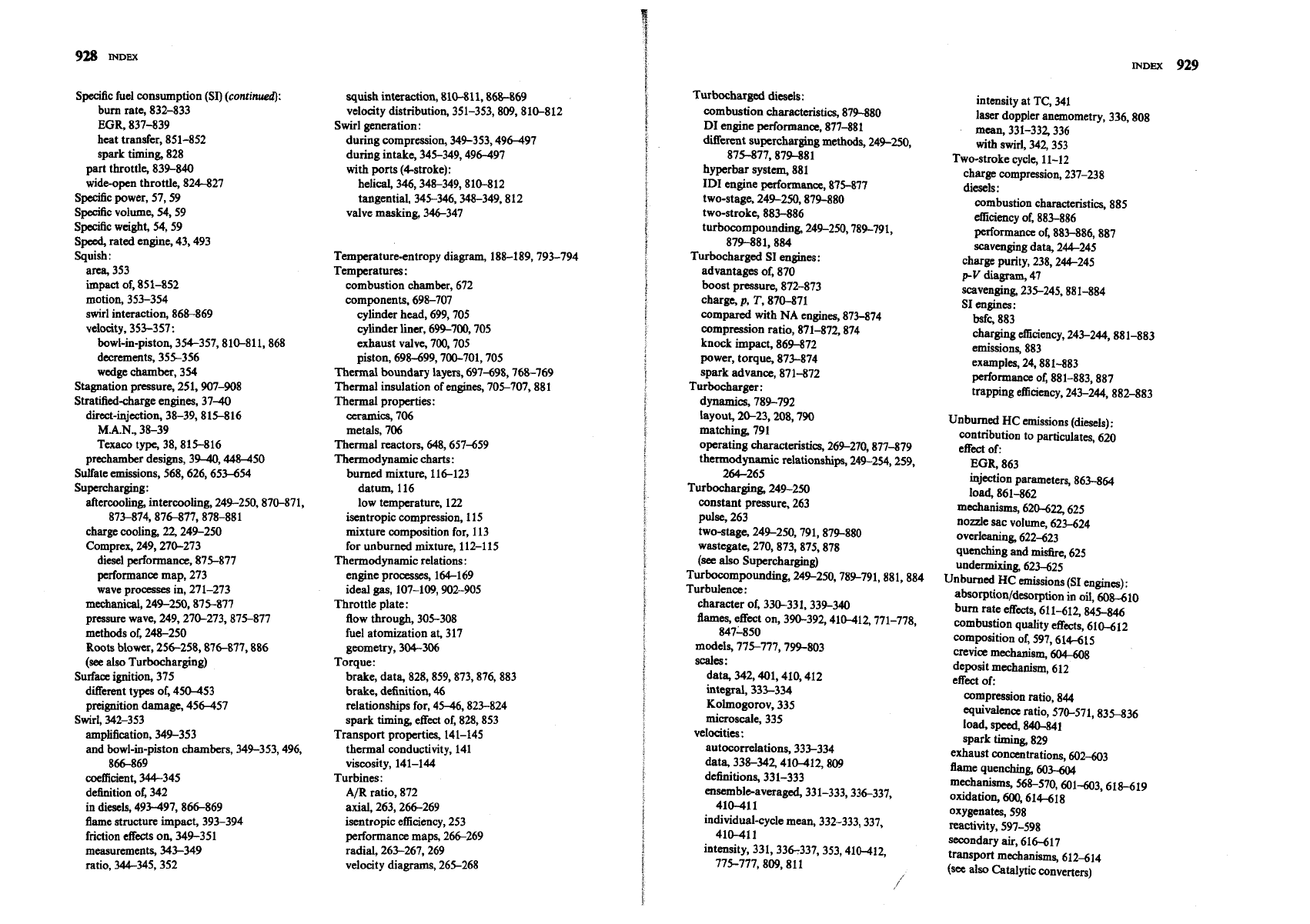
Specific fuel consumption (SI)
(continued):
bum rate,
832-833
EGR,
837-839
heat transfer,
851-852
spark
timing,
828
part throttle,
839-840
wide-open throttle,
824-827
Specific power,
57,59
Specific volume,
54,59
S@c weight,
54,59
Sped, rated engine,
43,493
Squish:
area,
353
impact of,
851-852
motion,
353-354
swirl interaction,
868-869
velocity,
353-357:
bowl-in-piston,
354-357,810-811,868
decrements,
355-356
wedge chamber,
354
Stagnation pressure,
251,907-908
Stratified-charge engines,
37-40
direct-injection,
38-39,8 15-8 16
M.A.N.,
38-39
Texaco type,
38,815-816
prechamber designs,
3940,448-450
Sulfate emissions,
568,626, 653-654
Supercharging:
aftercooling, interwoling,
249-250,870-871,
873-874,876-877,878-881
charge cooling,
22,249-250
Comprex,
249,270-273
diesel performance,
875-877
performance map,
273
wave processes in,
271-273
mechanical,
249-250,875-877
pressure wave,
249,270-273,875-877
methods of,
248-250
Roots blower,
256-258,876877,886
(see
also Turbocharging)
Surface ignition,
375
different types of,
450453
preignition damage,
456-457
Swirl,
342-353
amplification,
349-353
and bowl-in-piston chambers,
349-353,496,
866869
dcient,
344-345
definition of,
342
in diesels,
493-497, 866-869
flame structure impact,
393-394
friction effects on,
349-351
measurements,
343-349
ratio,
344-345,352
squish interaction,
810411,868-869
velocity distribution,
351-353,809,810-812
Swirl generation:
during compression,
349-353,496-497
during intake,
345-349,496-497
with ports (4-stroke):
helical,
346, 348-349, 810-812
tangential,
345-346,348-349,812
valve masking,
346-347
Temperature-entropy diagram,
188-189,793-794
Temperatures:
combustion chamber,
672
components,
698-707
cylinder head,
699,705
cylinder liner,
699-700,705
exhaust valve,
700,705
piston,
698499,700-701,705
Thermal boundary layers,
697498,768-769
Thermal insulation of engines,
705707,881
Thermal properties:
ceramics,
706
metals,
706
Thennal reactors,
648,657-659
Thermodynamic charts:
burned mixture,
116-123
datum,
116
low temperature,
122
isentropic compression,
115
mixture composition for,
113
for unburned mixture,
112-115
Thermodynamic relations:
engine processes,
164-169
ideal
gas,
107-109,902-905
Throttle plate:
flow through,
305-308
fuel atomization at,
317
geometry,
304-306
Torque:
brake, data,
828,859,873,876,883
brake, definition, 46
relationships for,
454,823-824
spark timing, effect of,
828,853
Transport properties,
141-145
thermal conductivity,
141
viscosity,
141-144
Turbines:
A/R ratio,
872
axial,
263,266-269
isentropic efficiency,
253
performance maps,
266-269
radial,
263-267,269
velocity diagrams,
265-268
Turbocharged diesels:
combustion characteristics,
879-880
DI engine performance,
877-881
different supercharging methods,
249-250,
875877,879481
hyperbar system,
881
ID1 engine performance,
875-877
two-stage,
249-250,879-880
two-stroke,
883-886
turbocompounding,
249-250,789-791,
879-881,884
Turbocharged SI engines:
advantages of,
870
boost pressure,
872-873
charge, p,
T,
870-871
compared with NA engines,
873-874
compression ratio,
871-872,874
knock impact,
869-872
power, torque,
873-874
spark advance,
871-872
Turbocharger:
dynamics,
789-792
layout,
20-23,208,790
matchiin&
791
operating characteristics,
269-270,877-879
thermodynamic relationships,
249-254,259,
264-265
Turbocharging,
249-250
constant pressure,
263
pulse,
263
two-stage,
249-250,791,879-880
wastegate,
270, 873,875,878
(see
also Supercharging)
Turbocompounding,
249-250,789-791,881,884
Turbulence:
character of,
330-331,339-340
flames, effect on,
390-392,410412,771-778,
847-850
models,
775-777,799-803
scales:
data,
342,401,410,412
integral,
333-334
Kolmogorov,
335
microscale,
335
velocities:
autocomlations,
333-334
data,
338-342,41042,809
definitions,
331-333
ensemble-averaged,
331-333,336-337,
410-411
individual-cycle mean,
332-333,337,
410-41
1
intensity,
331,336-337,353,410412,
775-777,809,811
/"
intensity at TC,
341
laser doppler anemometry,
336,808
mean,
331-332,336
with swirl,
342, 353
Two-stroke cycle,
11-12
charge compression,
237-238
diesels:
combustion characteristics,
885
efficiency of,
883-886
performance of,
883486,887
scavenging data,
244-245
charge purity,
238,244-245
pV
diagram,
47
scavenging,
235-245.881-884
SI engines:
bsfc,
883
charging efficiency,
243-244,881-883
emissions,
883
examples,
24,881-883
performance of,
881-883,887
trapping efficiency,
243-244,882483
Unburned HC emissions (diesels):
contribution to particulates,
620
effect of:
EGR,
863
injection parameters,
863-864
load,
861-862
mechanisms,
620622,625
no& sac volume,
623-624
overkaning,
622-623
quenching and misfire,
625
undennixing,
623-625
Unburned HC emissions (SI engines)
:
absorption/desorption in oil,
60M10
bum rate effects,
611-612,845-846
combustion quality effects,
610612
composition of,
597,614-615
crevice mechanism,
604-608
deposit mechanism,
612
effect of:
compression ratio,
844
equivalence ratio,
570-571,835-836
load, speed,
840-841
spark
timing,
829
exhaust concentrations,
602-603
flame quenching,
603-604
mechanisms,
568-570,601-603,6i8-6i9
oxidation,
600,614-618
oxygenates,
598
reactivity,
597-598
secondary air,
616-617
transport mechanisms,
612-614
(see
also Catalytic converters)
